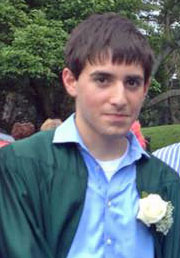 Today, Babson College Junior, Jonathan Kohlmeier, is a confident young man and a published author. Yes, an author at the age of nineteen. But it was not always thus.
Today, Babson College Junior, Jonathan Kohlmeier, is a confident young man and a published author. Yes, an author at the age of nineteen. But it was not always thus.
Just a Few Years Ago
There are quiet kids. And then there are QUIET kids. Jonathan was really quiet. When he first arrived at Rockland Country Day School, partway through eighth grade, he would sit in his classes, pay close attention, but never raise his hand. His teachers had been told not to challenge him, not to call on him, just to allow him to sit there and drink it all in.
And drink it in he did. He was obviously absorbed in whatever was going on and his tests and papers were exemplary. His teachers were delighted with his work but puzzled at his silence. Still, they respected the mandate to leave him be and made that necessary exception for him. He remained attentive, but generally silent, in class.
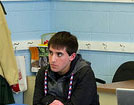
Intense Preparation for Debate Team
His was a small class even for that small independent school, only eight kids in the entire grade. But at RCDS, kids socialized easily with students both older and younger than they, and Jonathan was sought after because, after all, he seemed pretty cool. Jonathan, however, kept his own counsel for the most part – at least to begin with. He preferred to go off by himself, eat lunch in solitary splendor, work on his own in class and study hall as well as on the sports field. But he did allow some of the other kids to encroach in his space from time to time and began to make friends with his classmates as well as students both younger and older than he. He even began to speak up in class – not too frequently, at first, but with growing authority every time he did so.
The Challenge
Few had any idea just how difficult all this was for him. And what a triumph every classroom contribution, every social conversation represented. For Jonathan had early been diagnosed with an anxiety disorder, Selective Mutism, that made it near impossible for him to function in a normal social pattern away from his immediate family. He had been working on this problem for years, and this was one reason his parents brought him to a small, independent school, a place where a very bright but very anxious and inhibited young man might begin to find his place in the larger outside world.
Other than respecting his silence, he asked for no quarter and took midyear exams that first year even though he had only arrived shortly before the end of the term. He gradually began breaking down the wall he had erected around him and by the end of the year he was doing so on a regular basis, participating in all of his classes, adding as his advisor commented, ‘a quiet but strong presence and a wonderful dynamic to the class’, continuing that ‘Although Jon is a man of few words, he always has something meaningful to say’. By ninth grade, Jon was a fixture in the school and his wry sense of humour enlivened his increasingly frequent contributions to conversation.
Risk Taking, Competence and Confidence
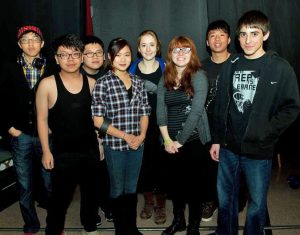
Jon (R), Leader of the Techies
As he gained in confidence, he also gained in determination – to battle his demons and bring them to heel, one at a time. He became, first, a sought-after member of his class which expanded over the years from its original eight members to nineteen; he became equally sought-after by members of the entire upper school, as his social world and ability to function within it expanded just as his class size had. His air of quiet calm, even in the midst of chaos (exhibited each drama season in the tech week that preceded school theatre productions with Jon, in charge of lighting, keeping everything grounded – a good thing in lighting!), his undeniable competence and his ability to problem solve without grandstanding all hoisted him into a leadership position. He still repaired to a quiet classroom to eat his lunch by himself but graciously accommodated others who came in with theirs, even tolerating their demands for conversation, the price paid for his heightened status at the school.
Preparation for Life After School
He realized, however, that he would eventually have to leave the relative shelter he had found at the school and decided to prepare himself for that day. After his sophomore year, then again after his junior year, he enrolled in college courses and went off first to Brown and then to Bentley to enroll in college classes and experience college living first-hand. This, the boy who in kindergarten could not bring himself to enter the classroom for weeks, who was unable to participate in academic or social activities and who waited until he returned home before he could even eat his lunch.
Jonathan not only survived but thrived during those daunting summers, just as he survived and thrived over his high school years. Then came senior year and the challenge not just of college but of facing everything that was to come with college and after – life itself.
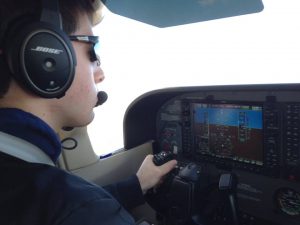
The Young Pilot
Enter WISE
And that’s where WISE came in. He could easily have done a WISE project on any one of his many interests – finance, flying (he had already earned a pilot’s license), technology, history. But he chose, instead, to look inward and do something much more dangerous — to explore himself. At the age of eighteen, he wrote his memoirs.
It was not an easy decision. Jonathan had never shared his experiences or his diagnosis with his peers. Few of his teachers knew the full story. Now he was going to tell that story, share it with everyone. Could he bring himself to do that? In his WISE journal, after wrestling with this question, he wrote:
I spoke to my mom about it, which took me all this time to get myself to do. She liked the idea but was not sure at first. She thought it might be too difficult for the both of us. It might reopen stuff that does not really want to be opened. She thought it might leave me vulnerable and was worried. I told her that I thought that I was ready and she said that she might not be. I told her that WISE is about learning about myself and that this would be the best way to do it. It also might bring some relief.
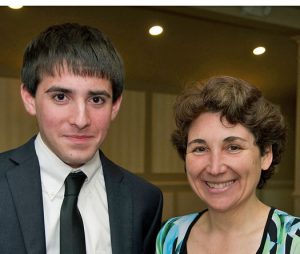
Jon and Mentor, Elisabeth Perez
Probing the Unknown & Uncomfortable
And he was off to the races. He chose, as his mentor, a language teacher with whom he felt truly comfortable, someone with whom he could talk about anything and everything. He sought advice from his English teacher, from the WISE coordinator, from the school psychologist. He began serious research, with The American Psychiatric Association’s Diagnostic and Statistical Manual of Mental Disorders (DSM) diagnosis of Selective Mutism, then expanded his research, reading up on the condition and on social anxiety in other sources. He also began to look for books, including works of fiction, that dealt with similar situations and found them not just helpful but inspiring. He contacted the school psychologist from his local school district who was familiar with his case and who had overseen the testing done for him to find out more about what she and the teachers had seen in him in his earlier years. He made an appointment with the first psychiatrist who had diagnosed and then work with him when he was a small child to learn even more.
And he began grappling with the issue of going public with his situation. He had always kept his issues to himself but now other seniors were asking him what he was doing for WISE. He explained that he was writing an autobiography but, at first, gave few details. He knew he would have to make a presentation but to how many? He had many decisions to make.
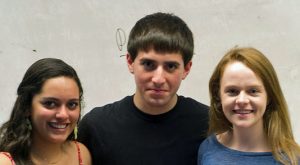
With other WISE friends
Developing a Mission
He found those decisions somewhat easier than he had anticipated. People from the past whom he had contacted – his first psychiatrist and the school district psychologist – asked if they could come to the presentation; then the psychologist told him that several of the teachers whom he had had during middle school also wanted to come; a few students to whom he gradually confided the nature of his topic shared, in return, their problems, one even disclosing an ongoing struggle with depression and the relief gained from sharing that struggle. Jon began to realise that, unusual as his specific condition might be, it was not all that unusual to be faced with challenges of this sort. Not only was he learning about selective mutism and anxiety and about himself, he was learning about the broader spectrum of mental health – and he was beginning to see himself as someone who  could not only educate others about his own little-known disorder but could function as a spokesperson for the larger world of mental health. In early June, he wrote in his journal: ‘A few people have asked me about my presentation because they want to go to it, but they can’t because there are finals during my presentation. I’m going to talk to Ms. Perez about what to do. I don’t want a lot of people to show up. But if people want to go, I think they should be able to go. The point of the book is outreach. The more people that get to hear about mental health, the better.”
could not only educate others about his own little-known disorder but could function as a spokesperson for the larger world of mental health. In early June, he wrote in his journal: ‘A few people have asked me about my presentation because they want to go to it, but they can’t because there are finals during my presentation. I’m going to talk to Ms. Perez about what to do. I don’t want a lot of people to show up. But if people want to go, I think they should be able to go. The point of the book is outreach. The more people that get to hear about mental health, the better.”
From Presentation to Publication
Jon’s presentation was everything a WISE presentation should be – and more. As his mentor summed it up in her final written evaluation: The presentation was very clear and conveyed the essentials of the project. Jonathan was able to achieve his goal which was to start writing a book, but, realizing that he wanted to concentrate in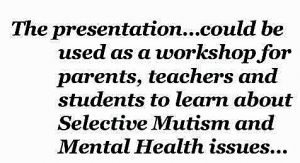 Mental Health issues, he let his project take a different path. The presentation was not just a presentation-it had a message, a personal message but also one with a professional aspect. The presentation could be used as a workshop for parents, teachers and students to learn about Selective Mutism and Mental Health issues, something he was able teach those of us who watched the presentation. Through this process Jonathan learned about himself and grew from it.
Mental Health issues, he let his project take a different path. The presentation was not just a presentation-it had a message, a personal message but also one with a professional aspect. The presentation could be used as a workshop for parents, teachers and students to learn about Selective Mutism and Mental Health issues, something he was able teach those of us who watched the presentation. Through this process Jonathan learned about himself and grew from it.
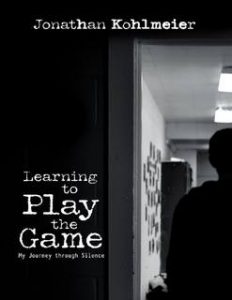 And Jonathan has gone on from there, not just to college, where, now a junior at Babson College he is majoring in Business Administration with a concentration in Computational & Mathematical Finance and a second one in Technology, Entrepreneurship, & Design. Somehow, in between college classes, outside internships and a myriad of activities, he has found time to go over what he had written his senior year and complete the book. The great start that he got during WISE propelled him forward in many different respects, enabling him to make another significant leap forward, this time sharing his experiences and understanding not just with his WISE presentation audience but with the outside world.
And Jonathan has gone on from there, not just to college, where, now a junior at Babson College he is majoring in Business Administration with a concentration in Computational & Mathematical Finance and a second one in Technology, Entrepreneurship, & Design. Somehow, in between college classes, outside internships and a myriad of activities, he has found time to go over what he had written his senior year and complete the book. The great start that he got during WISE propelled him forward in many different respects, enabling him to make another significant leap forward, this time sharing his experiences and understanding not just with his WISE presentation audience but with the outside world.
By his senior year in high school Jonathan Kohlmeier was already firmly on route to finding his voice, come what might. But WISE gave him time at a crucial point in his educational experience to explore the daunting challenges that he had faced, and faced down, one by one, to articulate the means through which he met those challenges and to lay out his path for the future. His is now an articulate voice for all those affected by mental health issues, conveying what it is like to suffer from anxiety or similar conditions and demonstrating that it is still possible to live a full and productive life with the proper assistance. His book will be a valuable addition to an all-important discussion of mental health, the realities and the issues that must be addressed.

 Saving...
Saving...